User Manual
User Manual

Welcome
Thank you for purchasing this cellular phone. To
guarantee your cellular phone works properly, please
follow the instructions in this manual to prevent any
possible incidents or malfunctions. Follow all safety
warnings to avoid injury or property damage. Screen
displays and illustrations in this user’s manual are
designed to help you operate your phone to its
optimum performance. We continuously strive to
improve our products. Therefore, we reserve the rights
to revise this user manual or withdraw it at any time
without prior notice.

Contents
GET STARTED..............................................1
KEY AND PARTS..........................................3
LOCK AND UNLOCK THE SCREEN...............4
MAKE IT YOURS..........................................5
ADD WIDGETS AND MORE ICONS.............6
TO HOME SCREEN......................................6
ENTER LAUNCHER......................................7
MAKE A CALL............................................. 9
REJECT A CALL BY SMS.............................11
ADD A CONTACT...................................... 12
SEND AND RECEIVE MESSAGE(S)............ 13
BROWSER THE WEB.................................15
ENJOY MUSIC...........................................16
DOWNLOAD APPLICATIONS....................17
FROM ANDROID MARKET....................... 17
MANAGE APPLICATIONS.........................18
MAINTENANCE & SAFETY........................19
GENERAL INFORMATION.........................22
SAFETY INFORMATION............................26
BATTERY INFORMATION..........................32
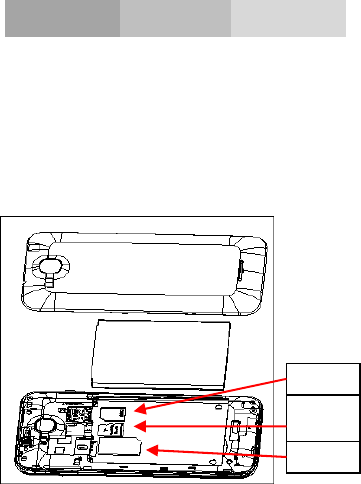
1
Get started
Insert SIM card
The phone is a Dual SIM mobile phone allowing you
to use the facility of two networks.
To insert SIM card(s):
1. Switch off the mobile phone and remove the rear
cover and battery.
2. Insert the SIM card correctly in the card slot(s) (See
figure below)
Micro
SD
SIM2
SIM1
2
3. Finally insert the battery and replace the rear cover
of the mobile phone.
Insert Memory card
1. Power off the mobile phone and remove the rear
cover and battery.
2. Insert the Micro SD card into the slot.
3. Finally insert the battery and the rear cover of the
mobile phone.
Note: Use only compatible memory cards for use with
this device. Incompatible memory cards may damage
the card or the device and corrupt the data stored in
the card.
Charge the Battery or Connect to a computer
You can charge your battery using the charger or
connect the USB cable (supplied with this phone) to
the computer.
Note: Please use the specific battery, otherwise it may
cause explosion.
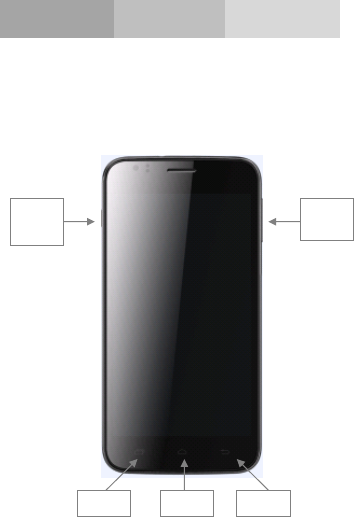
3
Key and parts
The smart phone gives you marvelous feelings to
experience on Camera, Video recorder, FM radio,
Music and Sound recorder. Let you install various
APPs, games, and more (supports APK format) by
downloading from Android Market.
Back
Power
key Volume
key
HomeMenu
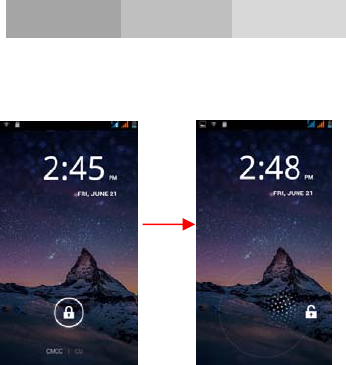
4
Lock and Unlock the screen
Press power button to enter Sleep mode and
meanwhile the screen will be locked; press power
button again to wake up and then drag to any direction
for unlock .
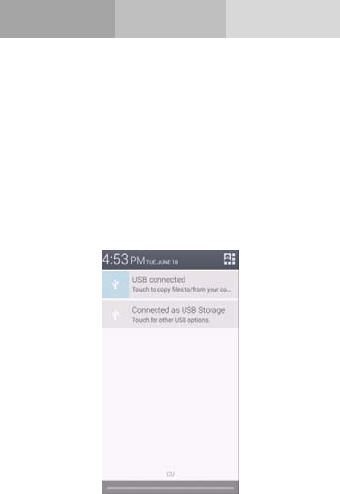
5
Make it yours
1. Home screen: It is your starting point to access all
the features on your phone. It displays application
icons, widgets, shortcuts, and other features. Long
press home screen and Modify Wallpaper.
2. Notification Bar: At the top of the screen, the Status
Bar displays the time, status, and notifications. If there
is a new message, missed call or something in the
notification bar, you can drag it down to open
notification panel and click the desired one to have a
view. When you finished, you can close it by dragging
the panel up or pressing “Back”.
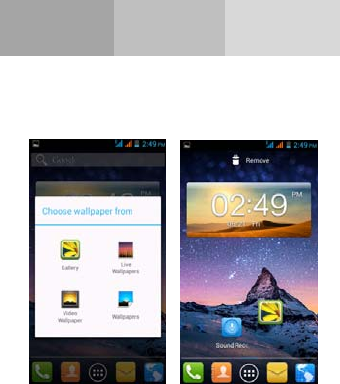
6
Add Widgets and more icons
to Home Screen
Long press Home screen, and then you can Modify
Wallpaper; or enter Launcher and long press and hold
an application till the screen vibrates, and then release
your finger hold.
Long press and hold the widget or icon you want to
move. Once the phone vibrates, don’t release your
hold on the icon. Drag the widget or icon to a new
location on the screen Press and hold on an icon till
the phone vibrates, and drag the widgets or icon to the
trash to remove!
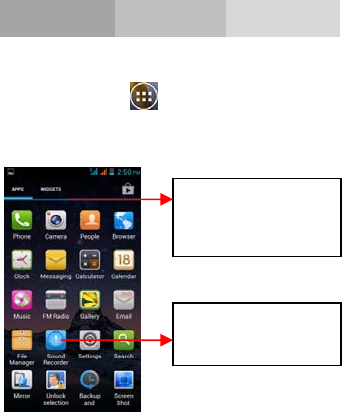
7
Enter launcher
Open and Switch Applications
At idle screen touch enter launcher
The Launcher holds icons for all of the applications on
your phone, including any application that you
downloaded from Android Market or other sources
Press Home icon or Back icon to close the Launcher.
Slide the Launcher
left or right to bring
more icons
Touch an application
to open it
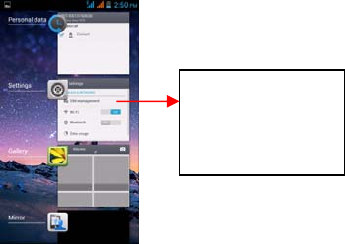
8
Switch to Recently Used Application
Press home key and hold the icon for a few seconds.
Touch an icon to
open an application
and slide it to the
rightorlefttoclose
it
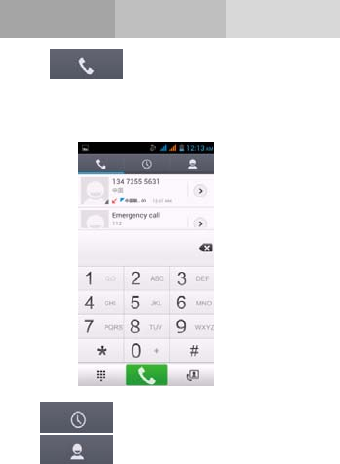
9
Make a call
Choose and enter a complete
phone number to make a call. Your phone supports
smart search.
Touch to view call log,
Touch to enter phonebook.
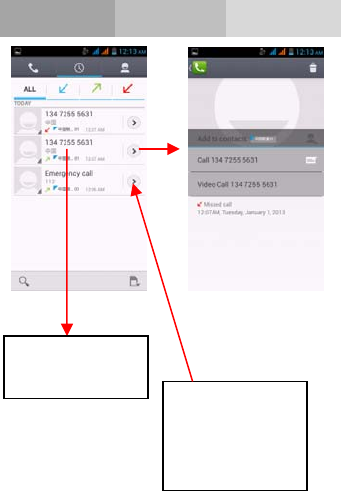
10
Call log
Press this point to
call directly
Press this point
enter menu, you
can call, video call,
view contact etc.
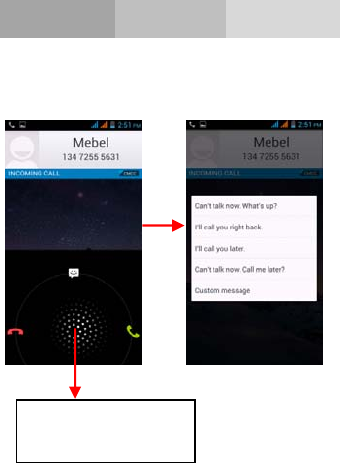
11
Reject a call by SMS
While there is an incoming call, and you are
inconvenient to accept the call, therefore you can send
a message for rejecting the call.
Drag this icon to select
and send SMS
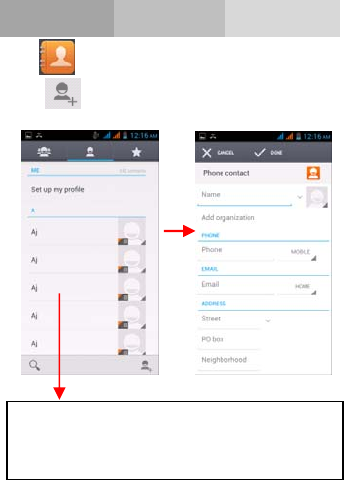
12
Add a contact
touch enter contact
Touch to add new contact
Click here for a contact and press menu key to
enter menu view, edit, delete contact, set
ringtone; share contact, etc.
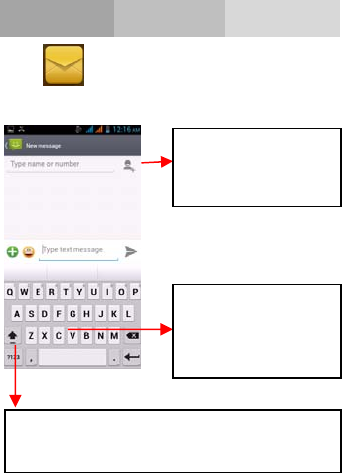
13
Send and Receive message(s)
Touch enter messaging, touch compose new
message
Touch once to capitalize the next letter you
type. Touch and hold for caps.
Press space or a
punctuation mark to
enter the highlighted
suggestion
Tap this icon to
select desired contact
from phonebook.
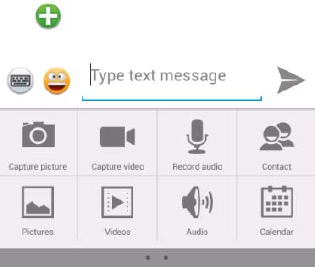
14
When you are composing a new text message, you can
select text for cutting or copying. The selected text is
highlighted in blue.
Tap to add “Attach” including Pictures, Videos,
Audios, etc to send MMS.
When a new message comes, you can read by
dragging notification panel and click the message, or
entering Message to read it directly.
Long press one of the all message thread, you can
delete thread”.
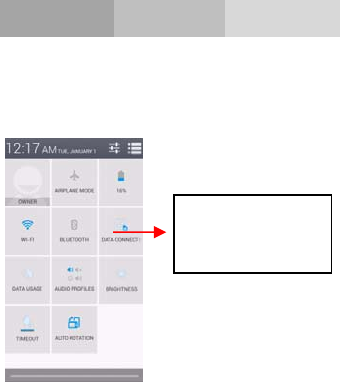
15
Browser the Web
a. Se
t
u
p
Internet/Data connection
Enter Settings > More…, scroll down to find out
Mobile network, and then enter “Access Points Names,
choose the desired WAP account.
b. Switch on Data connection or WiFi
To browse the web, you need to switch on Data
connection. If there is WiFi around, you can switch on
WiFi to use it browse the web.
Touch it to switch
on or off Data
connection
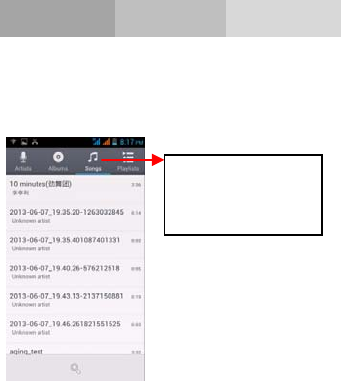
16
Enjoy music
When you copy music to your SD card, the Music
player searches the card for music fi les and builds a
catalog of your music, based on information about
each fi le that is stored in the fi le itself.
Touchatabtoview
your library in one
of four ways
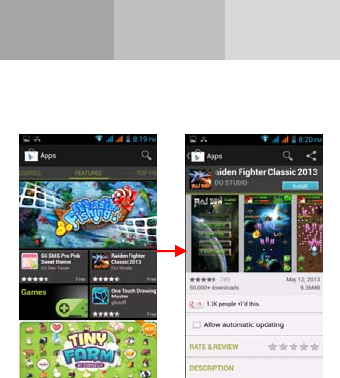
17
Download applications
From android market
1. Add Google accoun
t
2. Ente
r
play store (Android Market) and download
apps
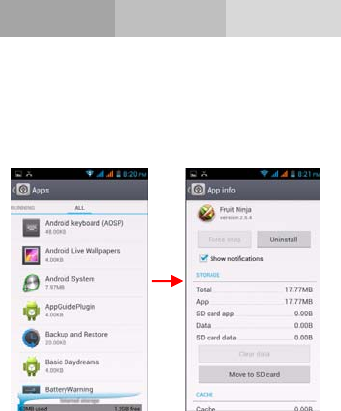
18
Manage Applications
As you install downloaded Apps, you need to switch
on “Unknown Sources” in Security settings.
Enter Setting > App.
Select one app, you can uninstall, clear data, move to
phone/SD card
Mobile Control: Mobile tracker & Peer control Code
is 1234.

19
Maintenance & Safety
Please read and observe the following information for
safe and proper use of your phone and to prevent
damage. Also, keep the user guide in an accessible
place at all the times after reading it.
1. After sales service
Kindly refer to the Warranty Card provided in the
sales package box.
2. Charger and Adapter Safety
Charger and adapter are designed for indoor use only.
3. Battery Information and Care
zPlease use the specific
b
attery, otherwise i
t
will
cause explosion.
zPlease dispose of you
r
b
attery properly.
zDo not disassemble o
r
short-circuit the
b
attery.
zKee
p
the
b
atter
y
’s metal contacts clean.
zRecharge the
b
attery afte
r
long periods of non-use
to maximize battery life.
zBatter
y
life will var
y
due to usa
g
e
p
atterns and
environmental conditions.
zThe self-protection function of the
b
attery cuts the
20
power of the phone when its operation is in an
abnormal status. In this case, remove the battery
from the phone, reinsert it, and turn the phone on
4. General Notice
Using a damaged battery or placing a battery in your
mouth may cause serious injury.
zDo not place items containing magnetic
components such as a credit card, phone card,
bank book, or subway ticket near your phone. The
magnetism of the phone may damage the data
stored in the magnetic strip.
zTalking on you
r
phone fo
r
long period of time
may reduce call quality due to heat generated
during use.
zWhen the phone is no
t
used fo
r
a long period time,
store it in a safe place with the power cord
unplugged.
zUsing the phone in proximity to receiving
equipment (i.e. TV or Radio) may cause
interference to the phone.
zDo not immerse you
r
phone in water. If this
happens, remove the battery and take it to an
Authorized Service Center.
zDo not paint you
r
phone.
zThe data saved in you
r
phone migh
t
b
e deleted
due to careless use, repair of the phone, or
21
upgrade of the software. Please backup your
important phone numbers. (Ring tones, text
messages, voice messages, picture, and videos
could also be deleted.) The manufacturer is not
liable for damage due to the loss of data.
zDo no
t
turn you
r
phone on o
r
off when the phone
is close to your ear.

22
General Information
Battery Care
Your phone is powered by a rechargeable battery
zThe volta
g
eran
g
eofthe
p
hone
b
atter
y
is 3.6 V -
4.2 V
zThe
b
attery can
b
e charged and discharged
hundreds of times but it will eventually wear out.
When the operating time (talk and standby) is
noticeable shorter than normal, you should buy a
new battery at the time.
zUn
p
lu
g
the travel char
g
e
r
when not in use, and
don’t leave the battery connected to a travel
charger for longer than a week, since
overcharging may shorten its lifetime.
zOvercharging may shorten its lifetime, and if lef
t
unused a fully charged battery may discharge
itself over time
zNeve
r
store o
r
charge
b
attery in extreme hot o
r
cold temperature, since extreme temperature can
shorten the life of your mobile phone and damage
battery
zUse only the charge
r
and
b
atteries tha
t
are
approved for use or recommended by the
manufacturer. Use any unqualified charger or
23
batteries may cause damages to your mobile
phone.
zUse the
b
attery only fo
r
its intended purpose.
zDo no
t
leave the
b
attery inside of you
r
ca
r
of in
extreme weather conditions, since extreme
temperature might cause damage to your battery
zDo not short-circuit the
b
attery. Short-circuiting
the terminals may damage the battery or the
connecting object.
zDispose of used
b
atteries according to local
regulations or manufacturer’s instructions. Do not
dispose of batteries in a f re.
zActual
b
attery life will depend on network
configuration, product settings, usage patterns,
battery and environmental conditions.
CAUTION: RISK OF EXPLOSION IF BATTERY
ISREPLACED BY AN INCORRECT TYPE.
DISPOSE OF USED BATTERIES ACCORDING TO
THE INSTRUCTIONS.
Charger attention
Attention: Please check the model of charger firstly
before using with this mobile phone.
Warning: Only use batteries, chargers, and
24
enhancements approved by the particular model.
Using any other types of batteries, chargers and
enhancements will invalidate the approval or warranty,
and may be dangerous. Please check with your dealer
for availability of approved enhancements. Please
grasp and pull the plug, not the cord when you
disconnect the power cord of any enhancement.
Care and maintenance
Your mobile phone is a highly sophisticated
electronic device. Please read this information before
using your mobile phone. If any device is not working
properly, take it to the nearest authorized service
center.
Product Care
zKeep you
r
mobile phone and all its parts ou
t
of
young children’s reach
zKeep you
r
mobile phone dry. Precipitation,
humidity, and all types of liquids or moisture can
contain minerals that will corrode electronic
circuits.
zAvoi
d
exposing you
r
mobile phone to extreme ho
t
or cold temperatures. The temperature range for
using the phone is 0°C-40°C.
zAvoi
d
placing you
r
mobile phone close to lit
cigarettes, naked fames or any heat source.
zDo not attempt to disassemble it. Only qualifie
d
25
personnel may install or repair your mobile
phone.
zDo not drop, knock o
r
shake you
r
mobile phone.
Rough handling can break internal circuit boards.
zDo not paint you
r
mobile phone. Pain
t
could
obstruct the earphone, microphone or any
moveable parts and prevent proper operation.
zTrea
t
you
r
mobile phone with care and keep it in
a clean and dust free place.
zDo no
t
use the phone if the antenna is damaged. If
a damaged antenna contacts skin, it may cause a
light burn. Please contact the nearest authorized
service center to replace the damaged antenna.
zUse chargers indoors.
zYou
r
mobile may have internal and external
antennas. As with any radio transmitting device,
avoid touching the antenna area unnecessarily
while the antenna is transmitting or receiving.
Contact with such an antenna affects the
communication quality and may cause your
mobile to operate at a higher power level than
proper operation needed and may reduce the
battery life.
zAvoi
d
using the phone at an altitude highe
r
than
3000 meters.

26
Safety Information
Access Codes
PIN code
The Personal Identification Number (PIN code)
protects your SIM card against unauthorized use. Your
SIM card usually supplies the PIN code. The password
can be obtained from your service provider. If the
incorrect PIN code occurred three times in succession,
you may need to key in PUK code.
PUK code
The Personal Unlocking Key (PUK code) is required
to change a blocked PIN code. The PUK2 code is
required to change a blocked PIN2 code. The
password can be obtained from your service provider.
If you key in an incorrect PIN2 code three times in
succession, you may need to key in the PUK2 code. If
incorrect PUK or PUK2 card cannot be used anymore.
You might need to contact your service provider for a
new card.
Radio frequency energy
Your mobile phone is a radio transmitter and receiver.
27
When the phone is turned on, it receives and transmits
radio frequency (RF) energy. Depending on the type
of mobile phone you posses, it operates on different
frequency ranges and employs commonly used
modulation techniques. The system handles your call
when you are using your phone and it also controls the
power level at which your phone transmits.
Specific Absorption Rate (SAR) information.
Your phone has been designed to comply with
applicable safety requirements for exposure to radio
waves. These requirements are based on scientific
organizations through periodic and thorough
evaluation of scientific studies. These guidelines
include safety margins designed to assure the safety of
all persons, regardless of age and health.
zThe radio wave exposure guidelines employ a uni
t
of measurement known as the Specific
Absorption Rate, or SAR. Tests for SAR are
conducted by using standardized method with the
phone transmitting at its highest certified power
level in all used frequency bands.
zThis phone is designe
d
to mee
t
the relevant
guidelines for exposure to radio waves.
zThe SAR limi
t
recommended
b
y the international
Commission on Non-Ionizing Radiation
Protection (ICNIRP), which is 2W/kg averaged
28
over ten (10) grams of tissue.
SAR data information for residents in
countries/regions that have adopted the SAR limit
recommended by the Institute of Electrical and
Electronics Engineers (IEEE), which is 1.6 W/kg
averaged over one (1) gram of tissue.
Electronic devices
Most modern electronic equipment is shielded from
RF energy. However, certain electronic equipment
may not be shielded against the RF signals from your
wireless phone, therefore:
zDo no
t
use you
r
mobile phone nea
r
medical
equipment without requesting permission.
Pacemaker
Mobile phones may affect the operation of some
implanted cardiac pacemakers and other medically
implanted equipments. Pacemaker manufacturers
recommend that a minimum separation of 20 cm. (6
inches) should be maintained between a hand-held
wireless phone and a pacemaker to avoid potential
interference with the pacemaker. These
recommendations are consistent with independent
research by the Wireless Technology Research
Association.
29
Persons with pacemakers
zShould always keep the phone more than 20 cm.
(6 inches) from their pacemakers when the phone
is switched on
zShould not carry the phone in a
b
reast pocket.
zShould use the ea
r
opposite to the pacemaker to
minimize the potential for interference.
zIf you have any reason to suspec
t
that interference
is taking place, switch off your phone
immediately
Hearing aids
zSome hearing aids might
b
edisturbed
b
y mobile
phones. In the event of such disturbance, you may
want to consult your service provider, or call the
customer service line to discuss alternatives.
Aircraft
zTurn off you
r
mobile phone
b
efore
b
oarding any
aircraft.• Do not use it on the ground without
crew permission. To prevent interference with
communication systems, you must not use your
mobile phone while the plane is in the air.
Potentially explosive atmospheres
Switch off your phone when in any area with a
30
potentially explosive atmosphere and obey all signs
and instructions. It is rare, but your phone or its
accessories could generate sparks. Sparks in such
areas could cause an explosion or f re resulting in
bodily injury or even death. Areas with a potentially
explosive atmosphere are often, but not always,
clearly marked. They include fuelling areas, such as
petrol station, below deck on boats, fuel or chemical
transfer or storage facilities, and areas where the air
contains chemicals or particles, such as grain, dust,
or metal powders, and any other area where you
would normally be advised to turn off your vehicle
engine.
Driving
Check the laws and regulations on the use of mobile
phones in the areas where you drive. If you are
going to use your phone while driving, please:
zGive full attention to driving.
zUse the “handsfree” setting. (Required
b
ylaw
in many countries).
zPull off the road and park
b
efore making o
r
answering a call if driving conditions so require.
RF energy may affect some electronic systems in
motor vehicles such as the car stereo, safety
equipment etc .In addition, some vehicle
31
manufacturers do not allow use of mobile phones,
unless the installation is supported by a handsfree kit
with an external antenna in their vehicles.
Check with your vehicle manufacturer’s
representative to be sure that your mobile phone will
not affect the electronic systems in your vehicle.
Emergency calls
Important:
This phone, like any wireless phone, operates using
radio signals, wireless and landline networks as well
as user programmed functions. Because of this
connections in all conditions cannot be guaranteed.
Therefore, you should never rely solely upon any
wireless phone for essential communications (e.g.
medical emergencies).
Emergency calls may not be possible on all wireless
phone networks or when certain network services
and/or phone features are in
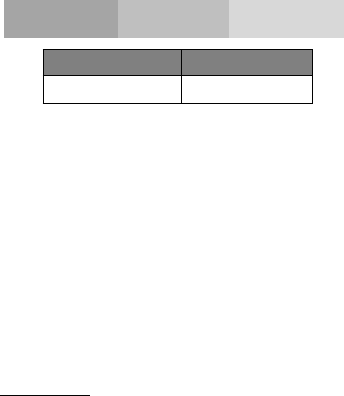
32
Battery Information
Type Capacity
Li-ion 2000mAh
zThe
b
atter
y
life de
p
ends on man
y
factors,
including the SIM card, network conditions,
settings, usage and environment.
zMakin
g
calls, turnin
g
on the
b
ackli
g
h
t
and music
player will consume more battery power.
zThe standby time is shorte
r
when the networ
k
is
not available than in the standard status.
zFo
r
p
owe
r
savin
g
,the
b
ackli
g
ht turns off
automatically if your phone stands idle for an
assigned time.
zThe
p
erformance of
b
atter
y
varies with the
charging status, temperature, local radio wave and
backlight status.
FCC Caution.
§ 15.19 Labelling requirements.
This device complies with part 15 of the FCC Rules.
Operation is subject to the following two conditions: (1)
33
This device may not cause harmful interference, and (2)
this device must accept any interference received,
including interference that may cause undesired operation.
§ 15.21 Information to user.
Any Changes or modifications not expressly approved by
the party responsible for compliance could void the user's
authority to operate the equipment.
§ 15.105 Information to the user.
Note: This equipment has been tested and found to
comply with the limits for a Class B digital device,
pursuant to part 15 of the FCC Rules. These limits are
designed to provide reasonable protection against harmful
interference in a residential installation. This equipment
generates uses and can radiate radio frequency energy and,
if not installed and used in accordance with the
instructions, may cause harmful interference to radio
communications. However, there is no guarantee that
interference will not occur in a particular installation. If
this equipment does cause harmful interference to radio or
television reception, which can be determined by turning
the equipment off and on, the user is encouraged to try to
correct the interference by one or more of the following
measures:
-Reorient or relocate the receiving antenna.
-Increase the separation between the equipment and
receiver.
34
-Connect the equipment into an outlet on a circuit
different from that to which the receiver is connected.
-Consult the dealer or an experienced radio/TV technician
for help.
Specific Absorption Rate (SAR) information:
This WCDMA+GSM Mobile Phone meets the government's
requirements for exposure to radio waves. The guidelines
are based on standards that were developed by
independent scientific organizations through periodic and
thorough evaluation of scientific studies. The standards
include a substantial safety margin designed to assure the
safety of all persons regardless of age or health.
FCC RF Exposure Information and Statement The SAR
limit of USA (FCC) is 1.6 W/kg averaged over one gram
of tissue. Device types: A4M (FCC ID: A4JANDYA4M)has
also been tested against this SAR limit. The highest SAR
value reported under this standard during product
certification for use at the ear is 0.83W/kg and when
properly worn on the body is 1.13W/kg. This device was
tested for typical body-worn operations with the back of
the handset kept 1.5cm from the body. To maintain
compliance with FCC RF exposure requirements, use
accessories that maintain a 1.5cm separation distance
between the user's body and the back of the handset. The
use of belt clips, holsters and similar accessories should
not contain metallic components in its assembly. The use
of accessories that do not satisfy these requirements may
35
not comply with FCC RF exposure requirements, and
should be avoided.
Body-worn Operation
This device was tested for typical body-worn operations.
To comply with RF exposure requirements, a minimum
separation distance of 1.5 cm must be maintained between
the user’s body and the handset, including the antenna.
Third-party belt-clips, holsters, and similar accessories
used by this device should not contain any metallic
components. Body-worn accessories that do not meet
these requirements may not comply with RF exposure
requirements and should be avoided. Use only the
supplied or an approved antenna.